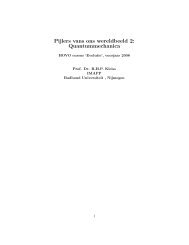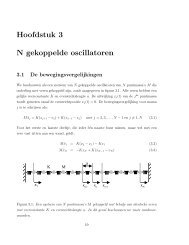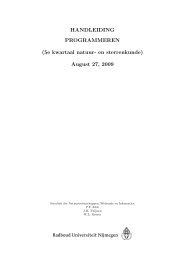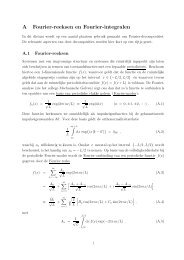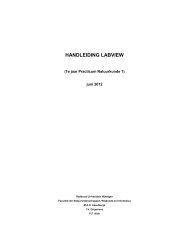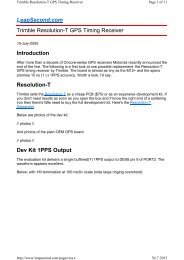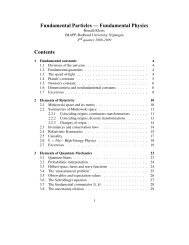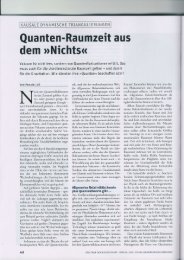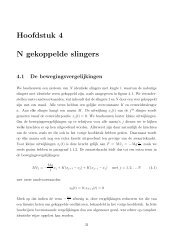Quantum Mechanics ¯h = 1.0545716 10 kg m sec
Quantum Mechanics ¯h = 1.0545716 10 kg m sec
Quantum Mechanics ¯h = 1.0545716 10 kg m sec
You also want an ePaper? Increase the reach of your titles
YUMPU automatically turns print PDFs into web optimized ePapers that Google loves.
Contents<br />
0 Words 5<br />
0.1 <strong>Quantum</strong> mechanics past, leading to present . . . . . . . . . . . . 5<br />
0.2 A road map . . . . . . . . . . . . . . . . . . . . . . . . . . . . . . 6<br />
0.3 Exercise 0 . . . . . . . . . . . . . . . . . . . . . . . . . . . . . . . 8<br />
1 States 9<br />
1.1 The state of a system : ket notation . . . . . . . . . . . . . . . . 9<br />
1.2 The superposition principle . . . . . . . . . . . . . . . . . . . . . <strong>10</strong><br />
1.3 Matrix notation . . . . . . . . . . . . . . . . . . . . . . . . . . . . 12<br />
1.4 Bases . . . . . . . . . . . . . . . . . . . . . . . . . . . . . . . . . 12<br />
1.5 The probability interpretation . . . . . . . . . . . . . . . . . . . . 13<br />
1.6 The measurement problem . . . . . . . . . . . . . . . . . . . . . . 14<br />
1.7 Bra’s and inner products : the Hilbert space . . . . . . . . . . . . 15<br />
1.8 Playing with light . . . . . . . . . . . . . . . . . . . . . . . . . . 18<br />
1.9 Exercises 1 to 6 . . . . . . . . . . . . . . . . . . . . . . . . . . . . 20<br />
2 Observables 23<br />
2.1 A measurement with a specific result . . . . . . . . . . . . . . . 23<br />
2.2 A measurement with a general result . . . . . . . . . . . . . . . . 24<br />
2.3 Using probability theory . . . . . . . . . . . . . . . . . . . . . . . 25<br />
2.4 Hermitean operators and eigenstuff . . . . . . . . . . . . . . . . . 26<br />
2.5 Observables as matrices . . . . . . . . . . . . . . . . . . . . . . . 28<br />
2.6 This is not a measurement ! . . . . . . . . . . . . . . . . . . . . . 29<br />
2.7 Degeneracy of eigenvalues . . . . . . . . . . . . . . . . . . . . . . 30<br />
2.8 What is a classical observable ? . . . . . . . . . . . . . . . . . . . 30<br />
2.9 Exercises 7 to 16 . . . . . . . . . . . . . . . . . . . . . . . . . . . 32<br />
3 Systems of observables 36<br />
3.1 More than one property . . . . . . . . . . . . . . . . . . . . . . . 36<br />
3.2 The commutator of two operators . . . . . . . . . . . . . . . . . . 36<br />
3.3 Commensurable observables and common bases . . . . . . . . . . 37<br />
3.4 Complete commensurable sets of observables . . . . . . . . . . . 38<br />
3.5 Incommensurability and information loss . . . . . . . . . . . . . . 39<br />
3.6 Commensurability and state labelling . . . . . . . . . . . . . . . 40<br />
3.7 The Heisenberg inequality . . . . . . . . . . . . . . . . . . . . . . 41<br />
3.8 Extra ! The Mermin-Peres magic square . . . . . . . . . . . . . 43<br />
3.9 Exercises 17 to 21 . . . . . . . . . . . . . . . . . . . . . . . . . . 44<br />
4 Does reality have properties ? 47<br />
4.1 The question at issue . . . . . . . . . . . . . . . . . . . . . . . . . 47<br />
4.2 The EPR paradox . . . . . . . . . . . . . . . . . . . . . . . . . . 47<br />
4.2.1 EPR’s thought experiment . . . . . . . . . . . . . . . . . 47<br />
4.2.2 Entangled states . . . . . . . . . . . . . . . . . . . . . . . 48<br />
4.3 Bell’s inequalities . . . . . . . . . . . . . . . . . . . . . . . . . . . 49<br />
2




